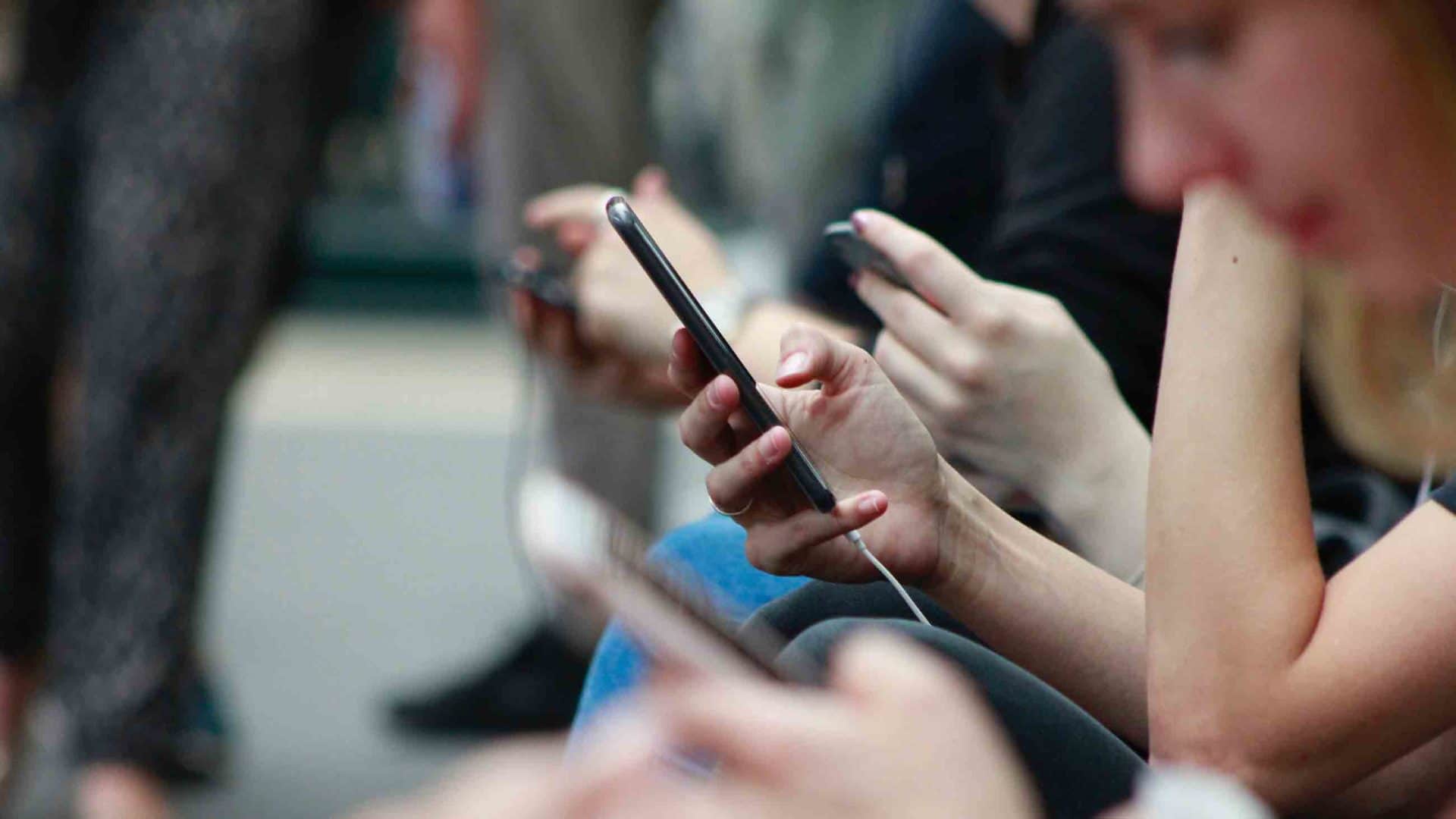One afternoon last April, at a coffee shop deep in suburban Philadelphia, I overheard a curious conversation between what looked to be a teenager and her grandfather. They were discussing the impacts of social media, and the girl bemoaned how depressed it made her feel. As an iPhone ironically buzzed in her palm, she explained that she couldn’t get off social media “because all of my friends are there.”
The girl’s conflicted relationship with her phone may actually be quite typical among modern-day teens. In a 2017 article in The Atlantic, psychologist Jean Twenge describes post-millennial teens as a generation nearly destroyed by smartphones. She writes that, in the age of Snapchat and Instagram, chat apps and social media have all but displaced young people’s real-life social interactions. Teens hang out with their friends less often than millennials did, they go on dates less frequently, and they are having less sex. They are statistically more likely to feel left out, lonely, and depressed — though these are, admittedly, correlations that don’t necessarily demonstrate causation.
It has become commonplace for media outlets to talk about this dark side of technology using the language of addiction. In a Washington Post op-ed earlier this year, for instance, psychologist Doreen Dodgen-Magee called on mental health professionals to recognize the bleak reality of “tech addiction.” In his New York Times column, Kevin Roose wrote about his “phone problem,” and how it had broken his brain. Parents and teens often signal their unhappiness with the amount of time spent online by framing the issue as smartphone addiction.
But to me, the confession from the girl in the Philadelphia coffee shop did not sound like that of a social media addict. Rather, it was a telltale sign of a powerful social norm in action. The distinction is critical: Whereas addiction is something people experience mostly as individuals, social norms are shared mental states shaped by the views and beliefs of other members of the society and by our subjective perceptions of those beliefs. And I believe that with appropriate interventions, social norms can be swiftly and completely overturned.
As a theoretical researcher in human behavior, I have spent the past two years studying social norms, the invisible rules that shape most of our social interactions. Norms are enforced through the approval or disapproval of a societal majority. The enforcement comes in many different guises — from verbal feedback, to barely noticeable glances and body language, to the guilt and shame that individuals feel when they fail to comply to the norm. Our behavior stems not just from our own choices and values but also from our beliefs about what others think is morally appropriate.
Take jaywalking, for instance. If we see that most people in an overcrowded urban center are jaywalking, we ourselves are more likely to jaywalk, out of fear of being labeled as an out-of-towner — even if we are perfectly aware of the risks. The same goes for social behaviors like recycling, littering, online dating, reviewing academic papers, hustling, and pretending to love work.
Strikingly, social norms often remain intact even when most people privately oppose them. In his latest book, “How Change Happens,” Cass Sunstein gives the example of female participation in the labor force in Saudi Arabia. There, guardianship laws give husbands the final say on whether their wives can work outside the home. The country’s low female employment rates suggest that the social norm is for husbands to forbid their wives from seeking employment.
But a recent study published by economists at the University of Chicago and the University of Zurich revealed that more than 80 percent of Saudi men surveyed were privately in favor of female labor force participation and that the men dramatically underestimate their peers’ support for female employment. Because of those false beliefs and the fear of social penalties, the men are reluctant to reveal their true preferences. This strengthens the existing norm, which even further incentivizes the men to keep their preferences hidden.
It does not have to be this way. Any given social norm represents only one of many possible social equilibria that could have emerged from the complex process by which private beliefs evolve into societal rules. These beliefs can mutate unpredictably as they spread from person to person and interact with existing norms and laws. And so Tokyo can have a strict social norm against standing on the right side of the escalator while Osaka and Kyoto have norms against standing on the left — and while Manila seemingly has no norm at all. Often there is nothing about the existing social equilibrium that makes it better or more rational than the alternatives; it exists simply because the circumstances were once just right for the norm to emerge.
Because there are many possible equilibria, social norms can — under the right conditions — shift from one equilibrium to another. Sometimes this happens gradually, but it often occurs rapidly and unexpectedly. Radical social change can take place, for instance, when people realize that their suppressed beliefs are in fact shared by many others, and that they can speak up and reveal their hidden preferences despite the potential social costs. In the Saudi employment study, when researchers intervened and corrected men’s beliefs about the expectations of their peers, the number of husbands encouraging their wives to sign up for a job-matching mobile application grew by nearly 60 percent among those who had underestimated the general level of support, and the number of women who actually applied for jobs outside the home grew by 10 percentage points.
Saudi men had been misled by the norm; I think post-millennial teenagers are misled too. Many are deeply unhappy spending so much time on social media and would rather hang out with their friends in real life. But because they believe that everyone else expects them to be on it, disclosing their true preferences has become too costly. The immense pressure of the norm means that no one can quit.
Framing the issue solely as social media addiction, besides being unhelpful, might in fact hinder social change. Measures that give teens and parents more control over the time they spend on social media — including Apple’s Screen Time and Android’s Digital Wellbeing — work well to increase awareness of our behavior, but they do nothing to change expectations about the private beliefs and hidden preferences of other people. Because of this, strategies that target individual behavior will be largely ineffective when it comes to changing the social norm.
Social norms involve entire societies of complex interacting individuals, stuck in an equilibrium they privately oppose. Because of their great power to govern human actions, they should be at the center of how we think about positive social change, and social media overuse is no exception. Indeed, if the dissonance between social media norms and the private beliefs of post-millennials is as strong as I think, it could be just a matter of time until the status quo is challenged. If enough people realize that many others are just as unhappy with the norm, change will happen.
Arunas L. Radzvilavicius is a postdoctoral researcher at the University of Pennsylvania and a research fellow at the Institute for Advanced Study in Berlin. He currently works on theoretical models of human behavior, evolution of social norms, and moral emotions.











Comments are automatically closed one year after article publication. Archived comments are below.
It is most definitely an addiction. As a parent of a teen, and a psychologist, I have been struggling to find a healthier way to integrate it into our lives. Every dm, every ‘like’, increases dopamine, and decreases patience and persistence. At best, communication and attention is reduced, and longer written work becomes laborious and uncreative. At worst, the ‘type it as you feel it’ catapults dramatic teen social interactions into intense bullying and suicidal ideation. Withdrawal occurs with irritability, moodiness, “boredom”, struggles to tolerate less immediate stimuli. Etc. Changing social norms are hard to do with constant steady hits of dopamine.
It’s always going to be less threatening/easier to put our best face digitally forward than making the effort to physically connect, as humans have evolved to socialize in this way.
It’s an addiction that is a social norm.
I’m not sure what’s more frightening, normalizing the addiction as your article does, or the disregard big tech will have in strategizing consumer attention *outside of ongoing dopamine inducing swipes.
There will be no resolving this IMHO, just aware or unaware members of society. Free of useless tech addiction, or enslaved. The implications are obvious and self evident, and reported in the article.
One love.
That many millions are alcoholics and drink socially at parties or bars does not mean it is not an addiction
Fact is, it IS an addiction that has become socially acceptable by the majority, like smoking was in the 60’s and 70’s- very dangerous and unhealthy. Walk through a university campus, and observe not one person (walking or driving) is paying attention with eyes forward, to watch where they’re headed. I’m a prof in ed psych, and addressing this issue on campus is an urgent priority. Two student pedestrians have been killed due to walking directly into oncoming
traffic – sadly, video of one incident showed the individual failed to look up from their screen long enough to realize they were entering the roadway. Warning signs and vocal “STOP” lights have proved useless, as the students are so engrossed in thumb-typing, they ignore their surroundings. Long-term damage to the developing child’s brain is real. It is a health crisis for us all.
Hi Dr. Ellis,
I’m so glad you mentioned college students because that is where I started my work with Mindhood.com. At Dartmouth College I ran a pilot last summer to create more mindful college communities through the intentional use of technology, face to face interactions, and mindfulness. Here is an article about that work. http://dartreview.com/mindhood-comes-to-dartmouth/
I’ve expanded to middle and high schools students, and hope to inspire college students to become role models for younger students. We started a podcast, lookuppodcast.com and are forming the 501c3 Look Up to inspire youth to find balance between their real lives and their technology. Step one is: “Look Up!”
I’d love to communicate further with you. I’m at [email protected]
In important factor of the Saudi study,I feel,if that the country is a patriarchial dictatorship that routinely kills and tortures. So that surely would be part of a man’s thinking in regard to giving his wife more rights.
I published the last response without my last name, and I’d love to connect with others about this issue.
While I understand the premise of social norming, I believe your comments missed the point that the use of technology today parallels exactly the DSM criteria for substance use disorder, with the exception of the substance. All of the criteria would be met for technology used to meet the DSM criteria. Addiction is not an individual disease but affects individuals on a biopsychosocial level. Entire families are disintegrating due to the over reliance on technology for communication. Individuals are obsessing over it’s use, it’s interfering with their lives, they experience periods of withdrawal and are severely impacted. While I also struggle with using the term addiction, It certainly appears that there is a serious dependence which is having devastating effects on individuals, families and our entire society. While this does describe changes and social norms and also parallels the issues were dealing currently with opiates and other substances creating dependence. I parallel this in my book, Turned On and Tuned Out: a Guide to Understanding and Managing Tech Dependence.
Hi John,
I 100% agree that digital addiction/tech dependence is a real problem. What I like about Arunas’ article is it offers an additional reason for teens 24/7 connectivity, and another way out. How can we galvanize youth to see the power of shifting social norms, and then how can we help them do that? I’m a co-founder and the Educational Liaison of the DigitalWellnessCollective.com and there are so many companies/soloproneurs/authors working on this problem. I’m excited to hear about your book because my next step is Amazon to buy it. I work with teens and college students, and they have solutions we haven’t thought of. I hadn’t thought about social norms, so the next question is how do we empower youth to begin to shift the social norms, while also looking up from their phones and living in real life, especially in this dopamine driven digital culture?